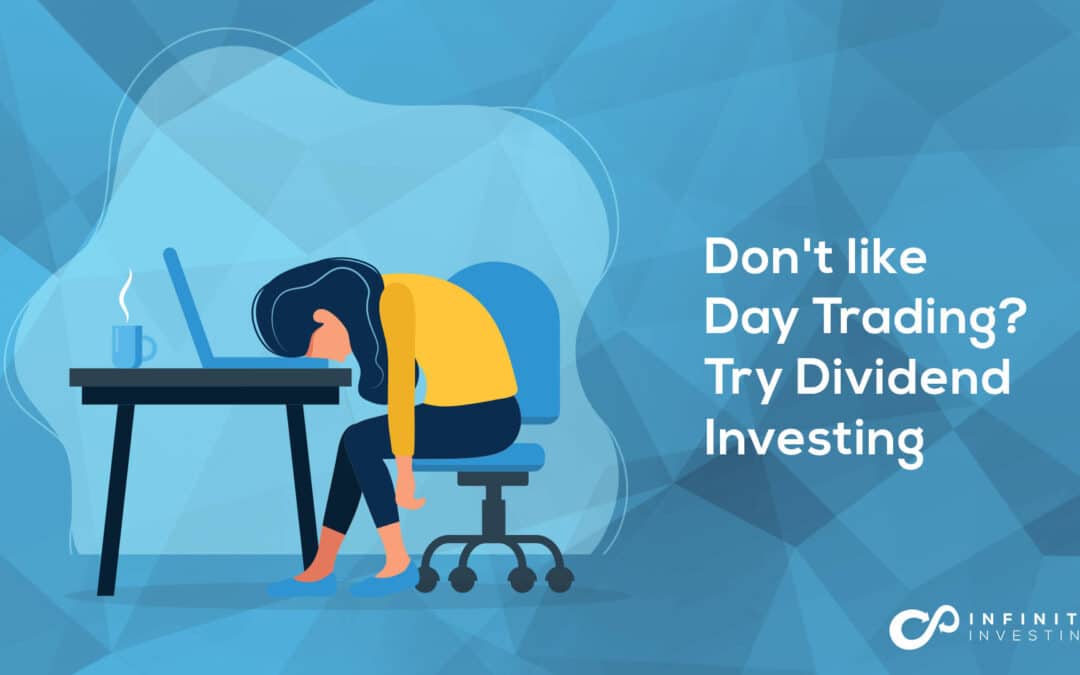
When building your portfolio, consider investing in dividend stocks. These stocks pay you a portion of a company’s profits based on the number of shares you own. If you choose to reinvest those dividends, you can boost your returns exponentially, setting yourself up with a steady source of passive income. We’ve put together this comprehensive step-by-step guide to help you get started with dividend investing.
Key Takeaways
- A dividend is a payout companies make to their stockholders on a regular basis, usually quarterly.
- You can use dividends as a source of income or reinvest them to increase your shares and boost your returns.
- Besides compounding gains, dividend reinvestments offer additional benefits, including convenience and flexibility.
- When purchasing dividend stocks, consider factors such as the dividend yield and payout ratio as you determine the best ones to buy.
- At Infinity Investing, we offer a variety of tools you can use to research and purchase dividend stocks to diversify your portfolio.
What Is Dividend Investing?
Dividend investing is an investment strategy that involves purchasing stocks from companies that pay a portion of their profits to stockholders. This payout is known as a dividend. In the same way you earn interest on a savings account, dividend investing allows you to earn additional income from the stocks you purchase. Most companies pay dividends on a quarterly basis, but some offer monthly or annual dividends.
Companies may offer either cash dividends or stock dividends. Cash dividends, which are more common, are cash payments you receive per share. For example, if a company pays a dividend of 10 cents per share and you own 100 shares, you would earn $10 in cash dividends. A stock dividend allows you to increase your shares in a company. For example, if the company offers a 15% stock dividend and you own 100 shares, the dividend would increase your shares to 115.
It’s important to note that not all companies pay dividends to their stockholders. It’s more common for mature companies to offer dividends since they’re no longer growing as quickly. Newer companies are more likely to reinvest their profits as they continue expanding.
Infinity Investing Featured Event
In this FREE event you’ll discover how the top 1% use little-known “compounders” to grow & protect their reserves. Our Infinity team of experts show you how to be the best possible steward of your finances and how to make your money and investments work for you instead of you working for them. Regardless of your financial situation today, you’ll have a road map to get to where you want to be.
How Dividend Stocks Work
Purchasing dividend stocks can allow you to generate passive income through your investments. When you buy a dividend stock, you can expect to receive your dividend on a specific date. While various factors, such as the economy and a company’s performance, can affect dividends, these stocks generally provide a stable, predictable income over time. For this reason, many retirees choose to invest in dividend stocks to receive a steady income. However, dividend stocks can be a valuable investment for anyone who wants to generate passive income on the stock market.
When you invest in dividend stocks, you have a few options for the dividends you earn. You can:
- Reinvest your dividends to purchase more shares.
- Use the dividends to buy stock in another company.
- Spend the money.
- Save the dividends as cash.
What Is a Dividend Reinvestment Plan?
Reinvesting your dividends is a great way to compound the gains you earn on your investment. Many companies offer dividend reinvestment plans, or DRIPs, that allow you to reinvest your dividends into new shares of the company’s stock.
Many publicly traded companies offer DRIPs for dividend investors. Taking part in the program is usually free, and your dividends will go toward purchasing additional shares directly from the company.
Companies with DRIPs often allow you to purchase new shares at a discount without commission fees. However, most DRIPs have a minimum reinvestment amount, such as $10. Some companies offer flexible DRIPs that allow you to reinvest a portion of the dividends you receive so you can still receive cash payments as well.
Benefits of Reinvesting Dividends
DRIP investing can be a good option if you want to boost your returns. The advantages of reinvesting your dividends include:
- Compounding gains: Over time, reinvesting your dividends through a DRIP can provide compounding gains. As long as the stock increases, you’ll receive larger dividends, allowing you to purchase more shares and earn greater returns in the future.
- Ease of investing: Most companies allow you to reinvest dividends automatically as part of a DRIP. You can choose this option and never have to consider whether to buy or sell again.
- Flexible option: If you’re part of a flexible DRIP, you can usually pause automatic reinvestments if you need the cash instead.
- Discounted stock: If you choose to reinvest your dividends automatically, companies may offer you a discount on the current share price, usually from 1% to 10%.
- Lower risk: By choosing to reinvest your dividends, you lower the risk of your investment. Since you’re continually investing in shares over time, you don’t have to worry as much about the volatility of the market.

Tips for Dividend Investing
Dividend investing can allow you to diversify your portfolio while earning stable returns on your investment. When you choose to reinvest those dividends, they compound over time, leading to additional income in the future. If you’re ready to start investing in dividend stocks, here are some helpful tips to consider.
Search for Dividend Stocks
First, you need to identify companies that pay dividends to their stockholders. You can find these stock options by reviewing financial sites and comparing different options. Use the same criteria to evaluate dividend stocks as you do non-dividend stocks, such as a company’s performance, business model, and financial strength. At Infinity Investing, we offer multiple tools and resources to help you find the best dividend stocks for your budget and goals.
Determine the Dividend Yield
The dividend yield is another essential metric to consider as you evaluate dividend stock options. The dividend yield will tell you how much you’ll receive for every dollar you invest in the company’s stock. You can calculate this metric by dividing the dividend amount by the share price of the stock. Here’s the formula:
Dividend yield = total dividend amount / cost of stock
For example, say you purchase 100 shares of a company at $100 per share, and the company pays $5 in cash dividends per share. To calculate the dividend yield, divide the total dividend amount you’ll receive by the cost of the stock:
Dividend yield = $500 (total dividend amount) / $10,000 (cost of stock) = 0.05
In this example, you’ll make 5 cents in dividends for every dollar you invest, giving you a dividend yield of 5%.
It’s important to remember that stocks with higher dividend yields don’t always mean they’re the best ones to purchase. A company’s dividend yield can increase as its share price falls, which can indicate trouble. In addition, a high-dividend stock may be a bigger risk if a company can’t sustain those dividends. Like all stock options, it’s essential to do your research to ensure you’re making a smart investment.
Evaluate the Payout Ratio
The payout ratio can also provide a good benchmark for comparing different dividend stocks. This ratio tells you how much a company is paying its stockholders in dividends. To calculate the payout ratio, divide the dividend per share by the share price. For example, if a company makes $1 per share and pays 50 cents per share in dividends, its payout ratio is 50%.
A lower payout ratio usually means a company pays sustainable dividends to its investors. You can research the payout ratio to learn whether the company has increased this rate over time. If so, this can be a great sign since it shows the company can provide dependable returns.

Consider Long-Term Growth
Unless you need to generate cash quickly, consider the long-term growth of dividend investing. With this mindset, you can purchase stock in growing companies that may have lower dividends right now but have the potential to increase those returns in the future. As the company becomes more established, its dividend yield will grow, and you can earn larger returns on your initial investment.
Choose Your Investment Strategy
As an investor, you have several options when it comes to choosing a dividend investment strategy. You can build a dividend portfolio by investing in companies with a proven track record of paying dividends to their shareholders. You can also invest in an exchange-traded fund or a mutual fund focused on dividend stocks.
You can also choose to use a DRIP to reinvest your dividends automatically. As we’ve outlined here, this method can be a valuable tool to grow your earnings and make passive income without continually having to buy and sell stocks.
Invest in Dividend Stocks With Infinity Investing
Dividend investing can be a low-risk, high-reward investment strategy to put your money to work for you. With this method of investing, you have the potential to boost your returns, bringing you one step closer to financial freedom.
At Infinity Investing, we aim to be an impactful, useful resource on your investment journey. Take your investment strategy to the next level with our membership options, which include tools such as on-demand trainings, weekly stock rooms, and live real estate investing analysis. Purchase a starter or pro membership today to start taking advantage of these wealth-building resources.
Infinity Investing Featured Event
In this FREE event you’ll discover how the top 1% use little-known “compounders” to grow & protect their reserves. Our Infinity team of experts show you how to be the best possible steward of your finances and how to make your money and investments work for you instead of you working for them. Regardless of your financial situation today, you’ll have a road map to get to where you want to be.

